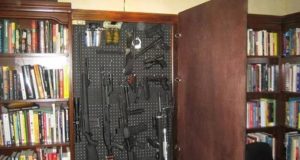 Ultimately your mindset is one of the biggest determining factors to your safety. For instance, look at special operations teams and special military and law enforcement units around the world. They practice in areas and situations that are simply “potential,” and they practice as though they are a normal occurrence. The muscle memory, the experience, the mental conditioning and the ability to work out the kinks are all benefits that come from preparedness and practice for situations that may never happen.
Ultimately your mindset is one of the biggest determining factors to your safety. For instance, look at special operations teams and special military and law enforcement units around the world. They practice in areas and situations that are simply “potential,” and they practice as though they are a normal occurrence. The muscle memory, the experience, the mental conditioning and the ability to work out the kinks are all benefits that come from preparedness and practice for situations that may never happen.
Understands The Fundamentals Of Gun Safety…
While you are doing daily tasks, think about the guy walking across the crosswalk; what you would do if he suddenly rushed you with a knife in hand?
What would you do if you were attacked at the ATM with your back turned to the public?
What would you do if the homeless guy in the park suddenly decided to get aggressive with you as you were trying to get into your vehicle?
What would you do if you were in the middle of making lunch for the kids and someone burst violently into the house with nefarious intentions?
These are mental exercises that can be used to help you become safer intrinsically and to add experience to your portfolio of training. You must know how to defend yourself both lethally and with non-lethal means, as certain situations will require certain reactions. Remember too, that threat equalization or threat elimination is THE MOST IMPORTANT task and goal in any self defense situation. It’s not about killing people, it’s not about being a hero, and it’s certainly not about putting yourself in harm’s way. You have potentially hundreds of outlets for action to avoid or decrease your risk exposure that include no action against an aggressor or attacker.
Utilize thinking. Go back to the different scenarios listed above and determine if it is best to run away, move out of harm’s way, call attention to the situation, or, of course, defend yourself with lethal or non-lethal measures. Having the practice under your belt will bring you into a much more comfortable and capable position. The constant practice our special operations teams get and perform is what keeps them alive. The training our SWAT teams get is what keeps them safe at their jobs. The training you do in preparation, including mental preparation and specific reactions to a variety of situations, will give you the edge.
You may want to consider taking a specific locally operated self-defense course offered by a reputable organization or which utilizes reasonable tactics and ideas. Often times the people offering courses do so with hype and trickery, not to mention shock marketing, to get revenue and visitors to their dojo or warehouse. Usually, they realize that self defense in any discipline takes a lot of time and dedication, not to mention fitness, and they have to convince people that they know what to do. Most of these “workshops” read like timeshare sales conventions and net a negative result, with little information or technique changing hands. It’s important to research these different offerings to determine their viability, as many of them put attendees in a much worse or even dangerous position by teaching them ineffective or completely useless techniques and ideas.
High-quality self-defense workshops run by well-known instructors from the military, law enforcement, or organizations devoted to martial arts at a high level are often very useful. Pay particular attention to those that have real-world applications and usability, as that is where you will want to use it. This isn’t the tournament at the end of the movie Karate Kid. The real-world experience you need to stop a threat is what you must focus on.
Utilize techniques and products that are accessible and easy to perform or use. Use what you have on you as well. Wasp spray is effective for deterring an attacker long enough for you to get away if you don’t have mace or need more volume to keep in your car. Distance is important too: use items to get farther away for an aggressor. The wasp spray isn’t illegal anywhere, it’s got great projection for the spray, and it is cheaper than just about any other deterrent. It has many similar effects to mace or pepper spray and can be used very effectively against an attacker if needed in a pinch. Sure, it’s rare that you will have a can of wasp spray in your purse, but you may have some under the seat of your car IF YOU BUY SOME. Sure, buy pepper spray if you can own it where you live and if you can afford it. Just remember wasp spray is useful too. The point is to look for alternatives and play out scenarios in your head so you can identify reasonable resolutions to issues in a whole host of other locations than the “standard” areas of attack.
Be able to use a knife and know how to not be disarmed of a knife during an encounter. Take a class or use other articles by this author to learn a few knife tricks and training techniques to help with the use of defensive knife work.
Try using a neck hit to incapacitate an attacker quickly and easily. The neck area is a very sensitive and vulnerable area that is often left unprotected while someone is attacking. A forearm or knee strike to the side or front of the neck can be devastating, but you won’t get many opportunities, so you MUST strike with confidence and purpose. A hit to the brachial areas of the sides of the neck or the windpipe on the front of the neck can buy you at least fifteen seconds, if not more, to run away or gain the upper hand. Think about your situation though; do not simply run away if you are forty-five miles out into the desert where you are easy to track, unless you are fairly certain that you can find a legitimate safe area or reach help. In that type of situation, use whatever you can to eliminate the threat, like a tire iron, the gun your attacker left on the front seat, etc. Try to assess your situation by being prepared, experienced, and educated enough to make the assessment in the first place.
Remember the goal is to eliminate the risk of threat—nothing more and nothing less, if you can control it.
©2012 Off the Grid News
 Off The Grid News Better Ideas For Off The Grid Living
Off The Grid News Better Ideas For Off The Grid Living




